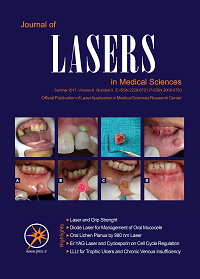Blind localization of heating in neural tissues induced by a train of the infrared pulse laser
Journal of Lasers in Medical Sciences,
Vol. 10 No. 4 (2019),
1 October 2019
,
Page 264-267
Abstract
Introduction: Recently, infrared lasers (wavelengths larger than 1100 nm) have been applied to stimulate neural tissues. Infrared neural stimulation (INS) has some advantages over conventional electric stimulation, including contact-free delivery, spatial precision, and lack of stimulation artifacts. In this study and based on a photothermal mechanism, we applied the heat diffusion equation to study temperature variation of a biological phantom during INS. In addition, the impact of laser parameters on spatially localized heating induced by two different infrared wavelengths were studied.
Method: We studied the localization of INS inside a phantom similar to cortical neural tissue. First, we analytically solved the heat diffusion equation to study the distribution of temperature inside this phantom. Then, the accuracy of analytical results was verified by heating the phantom using amplitude-modulated infrared lasers (lambda= 1450 and 1500 nm, the energy between 2 and 5 mJ and pulse duration up to 20 ms). The laser light was directed to sample by a multimode optical fiber (NA=0.22, Core size= 200 microns). Finally, the impacts of laser properties on the spatial resolution of infrared heating were discerned.
Result: In order to verify analytical results, we measured the maximum temperatures of the phantom during illumination of lasers and compared them with analytical results. The analytical results were in agreement with the experimental results. The effects of laser beam properties such as pulse duration, energy and repetition rate frequency on the spatial resolution were investigated. The results indicated that the spatial resolution of INS can be smaller than one millimeter.
Conclusion: Here, the influences of laser properties on the localization of INS inside a biological phantom were studied. These results can be applied to improve the spatial selectivity of the peripheral nerve interface.
- Infrared neural stimulation
- photothermal mechanism
- blind localized activation
How to Cite
References
Fribance S, Wang J, Roppolo JR, de Groat WC, Tai C. Axonal model for temperature stimulation. J Comput Neurosis. 2016; 41(2):185-192. doi: 10.1007/s10827-016-0612-x.
Cayce JM, Friedman RM, Chen G, Jansen ED, Mahadevan-Jansen A, Roe AW. Infrared neural stimulation of primary visual cortex in non-human primates. Neuroimage 2014; 84: 181-190. doi: 10.1016/j.neuroimage.2013.08.040.
Izzo AD, Walsh JT, Jansen ED, Bendett M, Webb J, Ralph H, et al. Optical parameter variability in laser nerve stimulation: a study of pulse duration, repetition rate, and wavelength. IEEE Trans Biomed Eng. 2007; 54(6):1108-1114. doi:10.1109/TBME.2007.892925.
Shapiro MG, Homma K, Villarreal S, Richter CP, Bezanilla F. Infrared light excites cells by changing their electrical capacitance. Nat Commun. 2012;3:736. doi:10.1038/ncomms1742.
Alemzadeh-Ansari MJ, Ansari MA, Zakeri M, Haghjoo M. Influence of radiant exposure and repetition rate in infrared neural stimulation with near- infrared lasers. J Laser Med Sci. 2019. doi: 10.1007/s10103-019-02741-4
Tan X, Rajguru S, Hunter Young NX, Stock SR, Xiao X, Richter CP. Radiant energy required for infrared neural stimulation. Sci Rep. 2015;5: 13273. doi: 10.1038/srep13273.
Norton BJ, Bowler MA, Wells JD, Keller MD. Analytical approaches for determining heat distributions and thermal criteria for infrared neural stimulation. J Biomed Opt. 2013;18(9):098001. doi: 10.1117/1.JBO.18.9.098001.
Liljemalm R, Nyberg T, von Holst H. Heating during infrared neural stimulation. Lasers Surg Med. 2013; 45(7): 469-481. doi: 10.1002/lsm.22158.
Wells J, Kao C, Konrad P, Milner T, Kim J, Mahadevan-Jansen A, et al. Biophysical mechanisms of transient optical stimulation of peripheral nerve. Biophys J. 2007;93(7): 2567-2580. doi:10.1529/biophysj.107.104786.
Peterson EJ, Tyler DJ. Motor neuron activation in peripheral nerves using infrared neural stimulation. J Neural Eng. 2013;11(1):016001. doi: 10.1088/1741-2560/11/1/016001.
Ansari MA, Erfanzadeh M, Mohajerani E. Mechanisms of laser-tissue interaction: II. Tissue thermal properties. J Lasers Med Sci. 2013;4(3): 99-106.
Bec JM, Albert ES, Marc I, Desmadryl G, Travo C, Muller A, et al. Characteristics of laser stimulation by near infrared pulses of retinal and vestibular primary neurons. Lasers Surg Med. 2012;44(9):736-45. doi: 10.1002/lsm.22078.
Ansari MA, Mohajerani, E. Mechanisms of laser-tissue interaction: optical properties of tissue. J Lasers Med Sci. 2011; 2(3): 119-125.
Welch AJ, Van Gemert MJ, Optical-thermal response of laser-irradiated tissue. Berlin: Springer; 2011.
Thompson AC, Wade SA, Brown WG, Stoddart PR. Modeling of light absorption in tissue during infrared neural stimulation. J Biomed Opt. 2012;17(7): 0750021-6. doi: 10.1117/1.JBO.17.7.075002.
Thompson AC, Wade SA, Cadusch PJ, Brown WG, Stoddart PR. Modeling of the temporal effects of heating during infrared neural stimulation. J Biomed Opt. 2013;18(3):035004. doi: 10.1117/1.JBO.18.3.035004.
You M, Mou Z. Model study of combined electrical and near-infrared neural stimulation on the bullfrog sciatic nerve. Lasers Med Sci. 2017;32(5):1163-1172. doi: 10.1007/s10103-017-2222-x.
- Abstract Viewed: 244 times
- PDF Downloaded: 199 times
